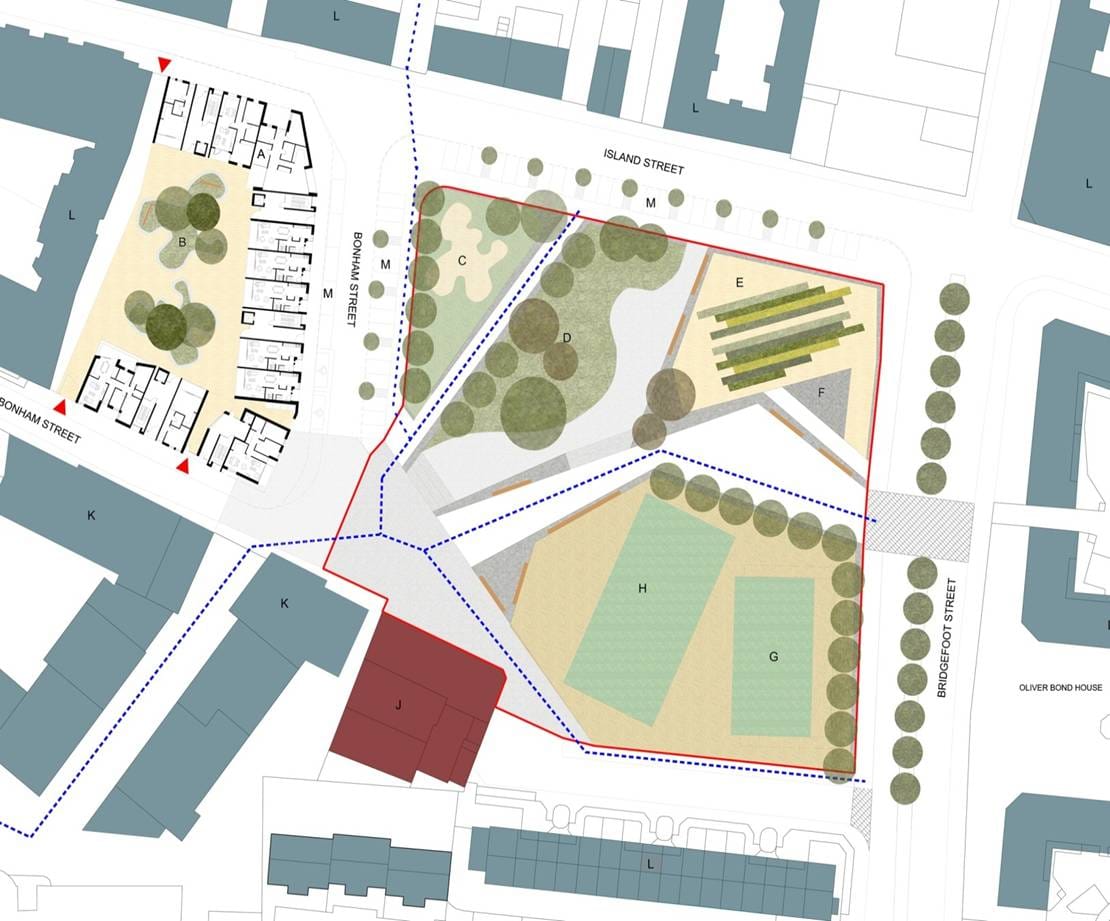What would become of the Civic Offices on Wood Quay if the council relocates?
After The Currency reported the idea of the council moving its HQ, councillors were talking about and thinking through the pros and cons and implications.
After discontent last summer, councillors and residents seem to be happy with the plans for the large vacant sites near the Oliver Bond flats.

Residents and local councillors seem happy with proposals unveiled recently for what will be built on two patches of vacant land on Bridgefoot Street in Dublin 8.
For years, residents had been pushing for a park there, but council officials had been eyeing up the site for housing.
Now it looks as if there might be both.
At the moment, the designs show a playground, community gardens, and some all-weather pitches on the larger, eastern vacant site.
The existing handball alley would be retained, and the community gardens would be moved from their current spot and get a new building to store tools and equipment.

On a smaller site, to the west, council officials hope to build 58 new social-housing units in a five-storey complex that would match the area’s existing building heights.
Last Wednesday, local councillors on the South Central Area Committee unanimously decided to send these plans out for public consultation.
Anthony Flynn, the executive manager of the council’s housing department, agreed with councillors when he said such a proposal was “long overdue”.
People Before Profit Councillor Tina MacVeigh said there’s broad public support for the proposals. “They are a great example of what can happen when you have good engagement with the community,” she said.
Some in the area have a more cautious welcome though.
“We are happy enough. As long as 50 percent of the social housing units go to local people and we have got the full-sized park,” said Tony O’Rourke, chairperson of the Bridgefoot Park Committee.
“Although we are not happy to be losing any green space,” he says – a nod towards the site that will be used for social housing.

Residents of Bridgefoot Street have been calling for a park to be built on the site since 2003, when the old Bridgefoot Street flats, built in the 1960s, were demolished.
In 2008, plans to build around 200 apartments and a community centre there, through a public-private partnership, collapsed following the economic crash.
Then, there was backlash from residents last summer after progress on a hoped-for park stalled, and there was talk of plans for some kind of emergency accommodation on the site.
MacVeigh says that the “determined concerted effort” of residents has paid off.
There has been a campaign for about two and a half years, she said, with weekly meetings among residents.
There are still signs up along the fence by the site, with information about how residents can get involved in the campaign, and arguments for why the need for a park in the area is so great.
O’Rourke says they fought hard to secure the park. “This is the most densely populated area in the state,” he said.
MacVeigh says the local residents have their own architects, so they will be able to contribute to the plans through the public consultation.
On Monday, Jim O’Shea was walking out of the flats where he lives, which face the site where the park is to be.
He wasn’t involved in the campaign, but seemed delighted a park is planned for the area. “It’s great for the kids, isn’t it? And it’ll be lovely to look out and see a bit a green,” he says.
Local residents and councillors had, in the past, raised concerns about plans to increase the number of social housing units in the area.
There’s already a high proportion of social housing there, and a lack of green space.
However, according to O’Rourke, residents are willing to accept the extra social housing as long as locals get some benefit from it.
According to the plans, the park will be on the main site, surrounded by Bonham Street, Island Street and Bridgefoot Street.
The 58 homes – 13 one-bedroom, 30 two-bedroom and 15 three-bedroom apartments – will be built on another smaller site, across the road at Bonham Street, where there is already some student housing.
Sinn Féin Councillor Críona Ní Dhálaigh said she’d been told that local residents would get preference for some of the units. There’s a need for three-bedroom homes in the area, she said.
The plans includes space for two all-weather pitches, which could be used for different sports, from soccer to basketball. They’re smaller than recommended five-aside pitches, though.
O’Rourke says it’s good that they’ll have a games area, but repeated his call for there to be full-sized pitches for kids to play in the Liberties, to keep them out of trouble.
“In the area we live in, there are no decent sports facilities,” says O’Rourke. “There is some seven-a-side pitches, but they are in a bad state of repair.”
For O’Rourke, the park is a small step in the right direction, but it’s not the end game.
“To us this park is just the start,” he says. “The question is how do you lower your social problems? You do that by providing amenities.”